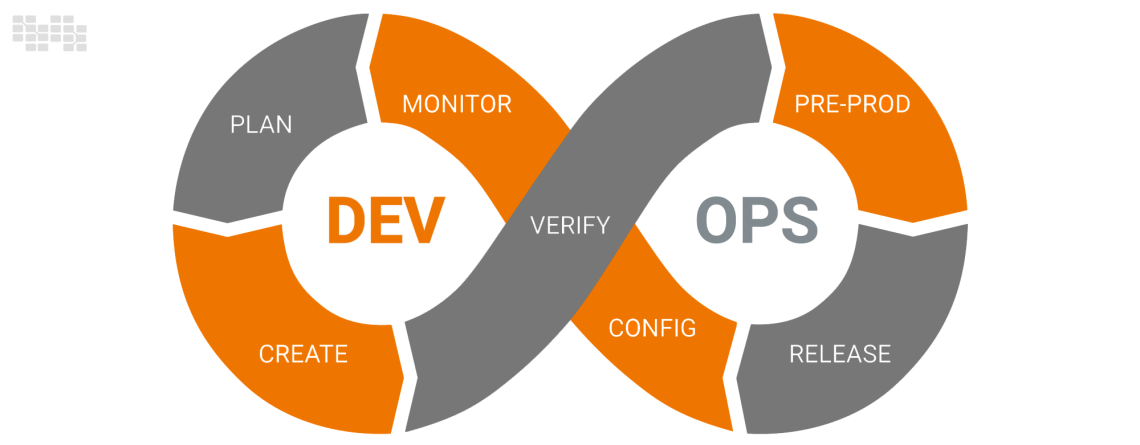Devops Best Practices
Aren’t there various, different combinations all around us that help us complete our daily duties more quickly and easily? Speaking from a technological POV (Point of View), some pairings are advantageous while others are simply odd. DevOps is a very gifted combination in the technological environment, and many generations are grateful for this invention. DevOps is an abbreviation that combines “the Development” and “the Operations” sides of the software development process. Many companies hold the misconception that by using the DevOps methodology, they would achieve success and have everything under control. But we must admit that it is erroneous. To get the required results, there is a need for constant DevOps best practices.
Setting up the cultural shifts, routines, and technological integrations that increase an organization’s capacity is what DevOps is all about. Businesses will be able to create high-performing apps and services thanks to DevOps best practices, which will also help them improve their products and development services more quickly than they could with traditional software development techniques and infrastructure requirements. DevOps and this blog are for you if your company wants to automate and streamline its operations. Find out everything you can about DevOps before deciding to use it instead of another app development method. In addition, your company can use all of our thoroughly proven and tested best practices.
What is DevOps?
This strategy, which is frequently mistaken for merely a development process, is focused entirely on creating a secure environment. DevOps is a corporate program that strives to improve communication and cooperation between development and operations teams in any software development process, if we were to define it. This innovative approach to fusing development and operations will automate, speed up software deployment, shorten the software development lifecycle, and produce high-quality software. For software development teams and the businesses for which they work, it’s a new way of working with all changes already in place.
According to Gartner’s DevOps statistics, the SaaS market will continue to grow steadily in the future year, surpassing all previous records and reaching $117.7 billion in 2021. Will this have an impact on the DevOps industry, if you have a question? Yes, given that DevOps is based on the CI/CD principles and that is the common procedure that encourages them to work in more virtual cloud environments.
Many firms are skeptical about whether or not to implement DevOps. It can be because they haven’t used it for their own business, because they don’t understand it, because of someone else’s prior experience, or even because of you. However, if your company has best DevOps practices in place, they can achieve the outcomes they had envisioned. We made the decision to present all the tried-and-true DevOps best practices in order to address this issue.
1. Agile Project Management
An iterative approach called agile project management and software development adds value to the software development process so that clients can get results more quickly and with fewer hiccups. Increased release frequencies will result from integrating agile into your business process since agile teams may concentrate on completing tasks in smaller batches rather than failing to achieve long-term deadlines. Teams may adjust to continuous input and pivot wherever it’s necessary by continuously evaluating needs, plans, and results.
Here are some of the essential ideas for agile project management:
- When you can take up large-scale projects, agile enables you to break it into smaller iterations, and teams must adjust to changes in demands or scope as they advance. Learn how to scope and structure work using features of agile methodology.
- Scrum and kanban are important project management methods for agile teams to consider. They help development teams to plan, track, and deliver incremental work without compromising deadlines.
2. Build a Collaborative Culture
When you begin using DevOps in your company, you encourage greater communication and openness among your team and IT infrastructure. DevOps enables you to close any gaps or silos across various teams, including the development, operations, and quality assurance teams. This approach enables you to create products and distribute them to customers more quickly. This level of cooperation can be achieved through changing the culture and working methods of the team. They will become more concentrated on reaching a single objective or group of goals as a result.
Both the development and operations teams must be aware of their duties in order to proceed toward the software development process smoothly and without difficulty if you want to meet the needs and expectations of your customers. In DevOps, everyone’s responsibilities, independent of their specific team positions, include development and operations.
3. Build with the Right Tools
Rain and water can you tell apart? In a similar vein, DevOps and automation cannot be separated. Good DevOps practices mainly rely on automation. Automating the process entails fully automating the development, testing, and delivery of software in any DevOps-based organization. This simplifies the lives of both developers and operations engineers.
DevOps tools will always be useful to you as a business, whether you need programming that tracks your performance data, alerts you when anything goes wrong, or provides you with a comprehensive perspective of your software development lifecycle.
4. Continuous Integration and Continuous Delivery
The CI/CD pipeline, the idea upon which DevOps is founded, has garnered a great deal of interest since it has been in operation. Briefly stated, continuous integration is a DevOps-based strategy where software engineers routinely merge source code into a centralized repository. The build and test processes are initiated by the CI pipeline on each merge on the repository. Typically, the central repository’s merged source code is obtained by the CI pipeline, which then builds it on the build environment and performs a number of automation tests on it. It helps the development team to receive bug feedback early and be able to address it.
As soon as the CI pipeline generates a successful build, the continuous delivery pipeline typically allows teams to deploy software releases on test, stage, or production environments. Additionally, this enables quality assurance engineers and developers to thoroughly test their work, make changes, and discover any bugs or issues in advance. It is now easy and affordable to automate the development and replication of numerous testing environments, which was previously challenging to do on-premises. To coordinate the CI/CD and other pipelines for the automation of development and operational processes, DevOps orchestration technologies are utilized.
5. Shift Left with CI/CD
When teams in DevOps employ this “shift left” strategy, testing the codes is incorporated early in the development cycle. Developers can therefore fix bugs or enhance code quality while working on the relevant region of the codebase by running a range of tests throughout the development process, as opposed to repeatedly submitting changes to a separate test or QA team. The methods of continuous integration, continuous delivery (CI/CD), and continuous deployment are the foundation for the capacity to shift left. The shift left methodology encourages teams to concentrate on early testing along with development, allowing teams to identify defects early and fix them quickly.
6. Monitor the Right Metrics
Continuity is one of the best practices used in DevOps. Since DevOps is an ongoing process, it is reasonable to state that continuous performance monitoring is the ideal approach. The effectiveness of a DevOps can be assessed by measuring the pertinent performance indicators, such as consumed effort, remaining effort, lead time, mean time to detect, and issue severity.
The ability to detect issues early and respond quickly makes data monitoring extremely vital. The objectives and expectations of your firm will be determined by the DevOps metrics. The correct metrics, including team velocity, success factors, unit cost, pertinent profitability, overall included cost, and other development team issues, can be attested to using DevOps.
7. Make a Move to Microservices
Microservices are a component of the DevOps philosophy, which involves segmenting large, complex projects into smaller units. Without affecting the entire system, various services can be developed, tested, and implemented independently. Microservices architecture is a technique for creating a single application as a collection of independent services. The user interface and access codes are combined into a single application in monolithic architecture, which is different from this. With the aid of an application programming interface, you can launch smaller apps as standalone services using the microservices design (API).
8. Implement Automation
DevOps and automation are synonymous terms, making automation a crucial component of the DevOps development process and one of its best practices. Software developers frequently have the duty of testing the apps. Efficiency is crucial in this process, which is why the majority of businesses prefer manual testing techniques. But the procedure becomes much more straightforward when you use DevOps. through automation The software development lifecycle is accelerated and made more efficient through testing in DevOps. Testers no longer need to repeat standard test procedures thanks to automated testing. To prevent defects, they can invest a lot of effort in creating creative test cases and working with developers.
Along with test automation, the complete DevOps pipeline—code merge, build, configure, deploy, test, provision, and release—can also be automated. In addition, automation in infrastructure configuration management and performance monitoring duties is a useful strategy. This motivates designers to address problems quickly and raise the standard of their work as a whole. The testing team can decide which automation tools and technologies would work best for them because there are many options available.
9. Continuous Security
We saw that when we use DevOps for enterprises, everything is consistent. Consistency is important, especially when it comes to security. Developers can have a reliable security backup with DevOps. The CI/CD pipeline and security technologies work together seamlessly, and DevOps rules don’t interfere with their agility or efficiency. With computers that are built utilizing trusted and confirmed credentials, intellectual property is significantly safer. You can group them according to priority before adding an additional degree of security by using various credentials. You can create test scripts that include the access rights for each category if you choose.
10. Gather Continuous Feedback
DevOps professionals use continuous feedback as an iterative approach to make sure team members are keeping track of all the tasks they need to finish by the deadline. This guarantees that the development, test, and operation teams will be promptly informed of any flaws in the pipeline. Additionally, it means that the team members will receive as soon as possible clear, accurate build, integration, and test results.
All performance, integration, build, and reported defect issues as well as development failures will be in a continuous loop and promptly informed to the product management team. The idea behind this development sprint is to allow the development team to move more quickly and with higher quality. One of the pillars of DevOps that enables both speed and quality is continuous feedback.
DevOps Benefits in Brief
The overall goal of the DevOps area is to increase workload distribution and interdepartmental collaboration. Let’s take the position of developers as an example. They might incorporate unit testing into their everyday activities, but if DevOps is in place, the sysadmins can independently repair some of the faults discovered during the deployment process. When DevOps is effectively incorporated into your business operations, you can:
- Lowered time to market
- Decreased number of failing software
- Reducing the time between repairs
- Increasing the frequency and consistency of deployments
- Getting down the average recovery time
These are some of the most obvious advantages that a company will experience after using DevOps.
Conclusion
We hope that after reading this instructive essay on DevOps best practices, you can now make informed decisions on DevOps. Both your internal DevOps engineers and engineers from outside firms assume full responsibility for how to work together consistently through ongoing testing, monitoring, and feedback loops. If done properly, utilizing DevOps for your company will be advantageous. To achieve this, understand the concept and depth of DevOps and train teams on how to use it for your requirements.













Leave a Reply